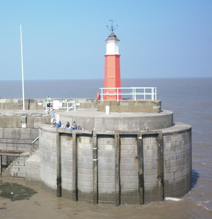Pictured: Watchet lighthouse on the north Somerset coast. Maritime Asset Security and Training (MAST) Ltd is helping CIRIA (the Construction Industry Research and Information Association) to develop a Risk Management Framework for dealing with Unexploded Ordnance (UXO), near-shore and offshore, in support of maritime construction projects.
The guidance will cover construction projects, such as energy infrastructure and wind farms at sea, including UXO risk management for ports, harbours and offshore installations which have been subjected to historical bombing or ammunition dumping.
CIRIA is consulting marine industry partners and operators to determine the best ways to comply, and what’s best practice on dealing with UXOs. CIRIA has hosted two seminars, to scope out the design engineering issues and challenges facing geophysical survey, risk analysis and the threats.
Richard Battrick, the EOD Technical Director at MAST said: “Between 600,000 and 1,000,000 naval mines of all types were laid during World War Two and a total of 48,000 aerial mines were delivered by the RAF alone in the European theatre. Air delivered mines were not particularly well chartered and the residual risk from UK and German offensive and defensive mine-laying remains a significant issue even today. MAST is proud to have put forward the concept of developing the guidelines on best practice for the UXO Risk Management Framework and is especially delighted to help support CIRIA in the co-ordination of this document.”
Developments in coastal and off-shore locations have increased over the past decade, the trainers say, and guidelines can collate best practice and give a blueprint for developers dealing with UXOs.
While guidance exists for developments and construction projects on land (Unexploded Ordnance (UXO): A guide for the construction industry (C681)), there is no such guidance for near-shore and offshore when dealing with explosive remnants of war. The inherent UXO risks facing the marine community also depends upon wartime and post-war activity in the region. Besides, ordnance at sea is affected by the tides, currents, sediment migration and marine growth. The proposed guidelines will aim to improve safety and eliminate risk, or at least reduce it to a level that is as low as reasonably practicable (ALARP) within the scope of maritime developments.
For further information visit: http://www.mast-commercial.com/
About MAST
Maritime Asset Security and Training (MAST) Ltd provides global security services for the maritime and oil and gas sectors. Holding membership of professional bodies, MAST is also ISO 9001:2008 accredited for the provision of global maritime security services for the shipping and yachting industry and holds the ISO 14001:2004, the criteria for an environmental management system.










